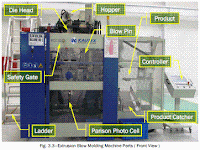Extrusion Blow Molding Machine Parts and Functions
• Extruder Motor—Drives the screw in the barrel to rotate and push the
melted material into the die head.
• Gearbox—Reduces the speed of the extruder motor into a required speed enough to push the material into the die head.
• Hopper—A feed reservoir into which the material is loaded.
• Extruder—A part of the machine that accepts solid resin material, conveys it in a surrounding barrel by means of a rotating screw, melts the
material by means of heaters, and pumps it under pressure into the die
head.
• Cooling Fans—Cools down the barrel during machine shut down to prevent the material from degradation.
• Heating Bands—Device attached on the barrel and the die head used to melt the solid material at a required set temperature.
• Die Head—Used to form the melted resin into a parison and also used for adjusting the characteristics of molten resin to create a stable parison.
• Die & Pin—Used to align the flow of parison to get a good and centered parison.
• Hot Cutter—Cuts the parison after the mold is closed for the blowing process.
• Blow Pin—Used to blow compressed air into the parison to inflate it after the mold has been closed and form the desired design of the mold.
• Mold—A hollow form or a cavity into which a molten plastic material, called parison, is introduced to give the shape of the required component.
• Deflasher—Used to cut the excess material on the bottle which is called a flash material (top and bottom).
• Post Cooling—A part of the machine that is used to cool down the inside of the bottle, to lessen the cooling time required inside the mold.
• Article Discharge—A part of the machine used to take the bottle out.
Higher Institute for Plastics Fabrication
WORKBOOK
for
Extrusion Blow Molding
Practical Course
Prepared by
Extrusion Blow Molding Department
1st Edition 2009
















